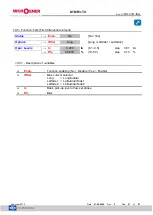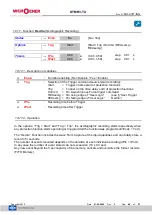
DTMR3-TX
Doc. N°
MO-0377-ING
Copyright 2010
Data
01.04.2009
Rev.
0
Pag.
34
of
87
14.8.5
– Blocking Logic (BO-BI)
For each Protection Function it is possible to activate a Blocking Logic allowing for inhibiting their
operation by external signals provide to the Digital Input.
14.8.5.1
– Output Blocking signal “BO”
All the protection functions that can be programmed to operate in the blocking logic mode,
element, have an instantaneous element (beside the time delayed) which is operated as soon as
the controlled quantity exceeds the set trip level (I> [Is] for current, etc..) and it’s instantaneously
reset when the input quantity drops below the reset level (normally 0.95Is).
The instantaneous element can control one of the user programmable output relays that, by its
contacts, makes the signal available for blocking an external element (BO = Blocking Output).
In case, “tBO” sec after the set trip time “ts” has expired, the Protection function is still in operation
(current above trip level), the Blocking Output relay (instantaneous element) is anyhow reset to
eventually remove the Blocking signal from a back-up protection.
14.6.5.2
– Blocking Input “BI”
For all the functions controllable by the Blocking Logic, it is possible to inhibit the time delayed
tripping by an external signal that activates a Digital Input programmed for this functionality.
The programmed Digital Input gets activated by an external dry contact closing across its
terminals.
With the vari
able “tBI” set to “OFF” (tBI=OFF), the tripping of the delayed function is blocked as
long as the Blocking Input signal is present at the terminals of the Digital Input.
With the variable “tBI” set to “2xtBI” (tBI=2xtBI), 2xtBI seconds after the set trip time delay of the
function has expired the blocking input is anyhow ignored and the function enabled to trip.
14.8.6 - Automatic doubling of Overcurrent thresholds on current inrush
For some of the phase Overcurrent functions it is possible to have the set trip level [Is] automatically
doubled when strong inrush current is detected.
If at circuit Breaker switch-on (i.e. when the input current rises from zero to a minimum measurable
value) the current increases from 0 to 1.5 times the rated value [In] in less than 60ms, the set
minimum pick-up level [Is] is dynamically doubled ([Is]
[2Is]) and keeps this value until the input
current drops below 1.25xIn or the set time [t2xI] has elapsed.
This functionality is very useful to avoid spurious tripping of the instantaneous, or short-time
delayed Overcurrent elements, that could be experienced at switch-on of reactive loads like
Transformer or Capacitors.
















































